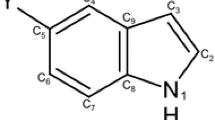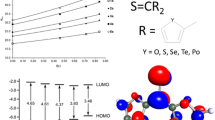Abstract
The effect of replacing the hydrogen atoms in thioformaldehyde by halogen atoms (F, Cl) on the ionisation potential of the non-bonding electron is analysed by using the Hellman-Feynman theorem, regarding the nuclear charge of the substituent as a parameter in the many-electron Hamiltonian. The trends predicted by our theory nicely agree with the relevant ionisation potentials computed either by applying Koopmans’ theorem or by the ΔE SCF method. For the carbonyls, avaible experimental data indicate the reliability of our prediction.
Similar content being viewed by others
References
Brundle C R, Robin M B, Kuebler N A and Basch H 1972J. Am. Chem. Soc. 94 1451 1466
Baker A D, Baker C Brundle C R and Turner D W 1968Int. J. Mass Spectrom. Ion Phys. 1 285
Banerjee M and Bhattacharyya S P 1980J. Phys. Chem. (Communicated)
Carlson T A 1975Photoelectron and Auger Spectroscopy (New York: Plenum)
Feynman 1939Phys. Rev. 56 340
Feller D, Borden W T and Davidson E R 1980Chem. Phys. Lett. 71 22
Ghosh P K 1978A Whiff of photoelectron spectroscopy (New Delhi: Published by the author)
Hellmann J 1973Einfuhrung in die quantenchemie (Deuticke, Leipzig)
Kroto H W and Suffolk R J 1972Chem. Phys. Lett. 15 545
Koopamans’ T 1933Physica, S Grav 1 104
Pople J A, Santry D P and Segal G A 1965J. Chem. Phys. 43 S 136
Pople J A and Segal G A 1965J. Chem. Phys. 43 S 136
Pople J A and Segal G A 1966J. Chem. Phys. 44 3289
Turner D W, Baker A D, Baker C and Brundle C R 1970High resolution molecular photolectron spectroscopy (New York: Wiley)
Author information
Authors and Affiliations
Rights and permissions
About this article
Cite this article
Haque, M.A., Bhattacharyya, S.P. & Banerjee, M. Substituent effect on ionisation potential in a series of related molecules: A theoretical study in a molecular orbital framework. Proc. Indian Acad. Sci. (Chem. Sci.) 90, 407–415 (1981). https://doi.org/10.1007/BF02880852
Received:
Revised:
Issue Date:
DOI: https://doi.org/10.1007/BF02880852




